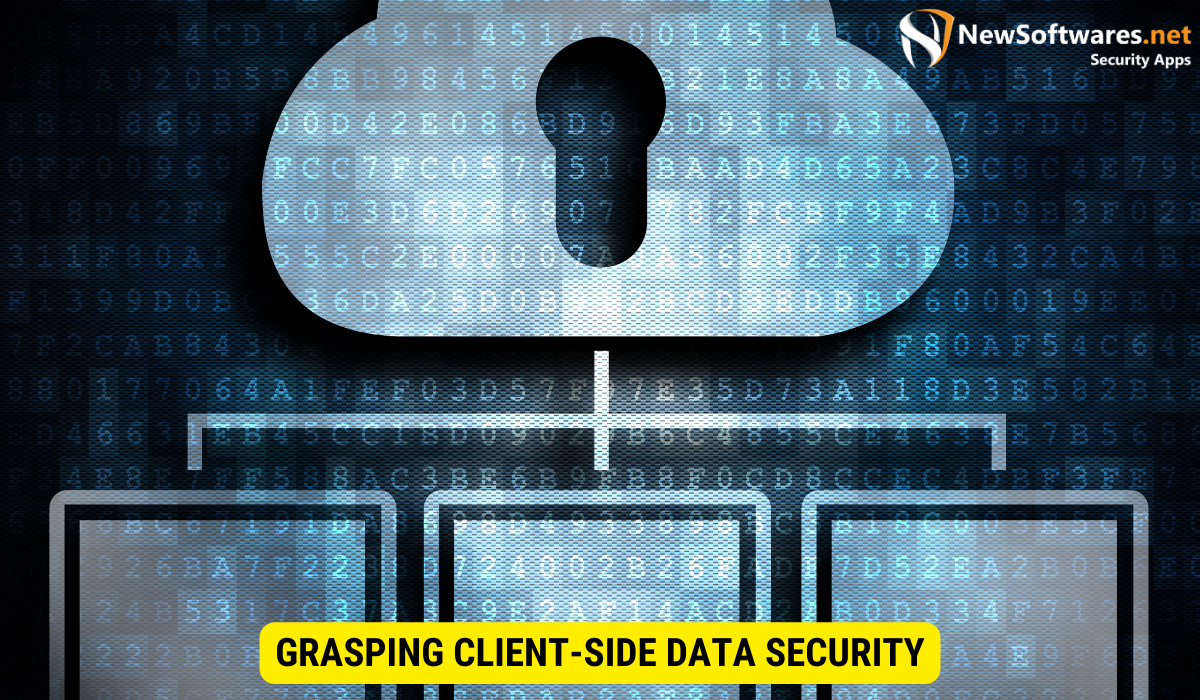Client-side data security involves protecting user data at its source with measures like encryption, secure file transfer protocols, secure code development, and multi-factor authentication. It’s essential for safeguarding sensitive information during online data transfers against threats like man-in-the-middle attacks, data breaches, and insider threats. To ensure robust security, organizations should implement strong authentication, utilize secure coding practices, and stay updated with emerging technologies like quantum encryption and AI.
Grasping Client-Side Data Security

In the realm of online data transfers, the significance of securing client-side data is paramount. This refers to the protective measures applied to data at the user’s end before it’s transmitted over the internet. It’s about ensuring the safety of data during entry, storage, processing, and eventual output.
Client-side data security is critical as it shields personal, financial, and intellectual property data from unauthorized access and potential threats. Without these protective measures, such sensitive data is at risk of being compromised, posing severe risks to individuals and organizations.
The Critical Nature of Client-Side Data Security
The trust and confidence of users hinge significantly on robust client-side data security. With the rise in cyber threats and data breaches, users are increasingly wary of where and how they share their personal data. By adopting stringent client-side data security measures, entities can affirm their dedication to user data protection, fostering trust and enhancing their reputation.
Furthermore, adherence to client-side data security is often mandated by various data protection laws like GDPR and CCPA. Non-compliance can attract hefty fines and legal repercussions.
Understanding Core Principles of Client-Side Data Security
To comprehend client-side data security fully, it’s crucial to understand several underlying concepts:
- Data Encryption: This process involves turning readable data into a coded form (ciphertext) using cryptographic algorithms, making it indecipherable to unauthorized entities without the corresponding decryption key. Popular encryption algorithms include AES and RSA.
- Secure File Transfer Protocols: Protocols like SFTP and SCP provide a secure method for transferring files over a network, employing encryption and other security methods to safeguard data in transit.
- Secure Code Development: Ensuring the security of code is fundamental for client-side data security. This means following best practices to avoid vulnerabilities, thus reducing the risk of security breaches.
- Secure Data Storage: Protecting data at rest is as crucial as securing it in transit. Implementing strong access controls, encryption, and backup solutions is vital for maintaining data confidentiality and availability.
- Multi-Factor Authentication (MFA): MFA introduces an additional layer of security, requiring users to provide multiple verification forms, making unauthorized access considerably more challenging.
Dissecting Secure Online Data Transfers
Secure online data transfers are a symphony of various components and protocols working in unison to maintain the confidentiality, integrity, and availability of data throughout the transfer process.
- The Role of Encryption in Data Transfers: Encryption is the backbone of secure data transfers, converting plain text into a secure format to prevent unauthorized access.
- SSL and TLS: These cryptographic protocols establish secure connections between clients and servers, providing essential encryption and authentication to safeguard data in transit.
Identifying Potential Risks in Data Transfers
Identifying potential risks in data transfers is crucial for maintaining the integrity, confidentiality, and availability of the data as it moves from one location to another. Here are some of the key risks involved:
- Interception (Man-in-the-Middle Attacks): Data transmitted over networks can be intercepted by unauthorized entities. Attackers might position themselves between the communicating users and discreetly alter or steal data, leading to information leakage, data corruption, or unauthorized data access.
- Data Breaches: During transfer, data might pass through multiple networks and servers, each posing a potential risk for breaches. Weak security measures can lead to unauthorized access and theft of sensitive data.
- Insider Threats: Not all threats come from outside an organization. Employees with access to sensitive data might accidentally or maliciously expose it during transfers, leading to internal data breaches.
- Insecure Endpoints: The security of data transfer is only as strong as its weakest link. Insecure endpoints, such as compromised or unprotected user devices, can be entry points for malware or unauthorized access.
- Lack of Encryption: Without encryption, data is vulnerable to being read and understood if intercepted. Transferring unencrypted data over insecure or public networks increases the risk of exposure and misuse.
- Poorly Configured Networks: Misconfigured network components, such as routers and firewalls, can create vulnerabilities that attackers might exploit to access or disrupt data transfers.
- Service Interruptions: Attacks like Distributed Denial of Service (DDoS) can target networks or services involved in the data transfer, leading to disruptions and potential data loss.
- Software Vulnerabilities: Software used for data transfer might contain vulnerabilities that, if exploited, can lead to data leakage or corruption.
- Compliance Violations: Different regions and industries have regulations governing data protection. Transferring data without complying with these laws can lead to legal issues and fines.
Strategies for Secure Online Data Transfers
Implementing strategies for secure online data transfers is crucial to protect sensitive information from unauthorized access and potential cyber threats. Here are some effective strategies:
1. Use Strong Encryption
- Data Encryption: Employ robust encryption standards like Advanced Encryption Standard (AES) to encrypt data before it’s transferred. This ensures that even if data is intercepted, it remains unreadable without the correct decryption key.
- End-to-End Encryption: Implement end-to-end encryption where only the communicating users can decrypt the message, ensuring data security from sender to receiver.
2. Secure File Transfer Protocols
- Use SFTP/FTPS: Instead of traditional FTP, use Secure File Transfer Protocol (SFTP) or FTP Secure (FTPS) for transferring files. These protocols provide an additional layer of security by utilizing encryption.
- HTTPS: For web-based transfers, ensure the use of HTTPS (Hypertext Transfer Protocol Secure) which encrypts the data exchanged between the client and the server.
3. Multi-Factor Authentication (MFA)
Implement MFA to verify the identity of users before granting access to transfer or receive data. This often involves something the user knows (password), something the user has (security token), and something the user is (biometric verification).
4. Regular Software Updates and Patching
- Update Regularly: Keep all systems and software involved in data transfers up-to-date with the latest security patches and updates to protect against known vulnerabilities.
- Security Software: Ensure that all devices involved in the transfer have reliable and updated antivirus and anti-malware software.
5. Network Security
- Firewalls: Use firewalls to monitor and control incoming and outgoing network traffic based on predetermined security rules.
- VPNs: Use Virtual Private Networks (VPNs) to create a secure connection over a less secure network, such as the internet, especially when using public Wi-Fi.
6. Access Controls and User Permissions
- Need-to-Know Basis: Ensure that data is accessible only to users who need it to perform their job functions. Implement strict access controls and permissions to restrict access to sensitive data.
- Audit Trails: Maintain logs and audit trails of who accessed the data and when, to monitor for any unauthorized access or anomalies.
7. Secure Coding Practices
- Input Validation: Ensure that applications validate input data to prevent common vulnerabilities like SQL injection and cross-site scripting.
- Error Handling: Implement secure error handling that doesn’t reveal sensitive information in error messages.
8. Employee Training and Awareness
- Security Training: Regularly train employees on the importance of data security, recognizing phishing attempts, and safe data handling practices.
- Policies and Procedures: Develop and enforce policies and procedures for handling sensitive data, including transfer processes.
9. Data Integrity Checks
- Checksums and Hashes: Use checksums and hashing to verify the integrity of the data before and after the transfer. This ensures that the data hasn’t been tampered with during transit.
10. Plan for Incidents
- Incident Response Plan: Have a well-defined incident response plan in place to quickly and effectively handle any security breaches or data loss.
By combining these strategies, organizations can significantly enhance the security of their online data transfers, ensuring the confidentiality, integrity, and availability of their sensitive information.
The Future of Client-Side Data Security

The field of client-side data security is continuously evolving. Noteworthy future trends include:
- The Emergence of Quantum Encryption: Utilizing the principles of quantum mechanics, this offers a highly secure method of communication.
- The Influence of Artificial Intelligence: AI can significantly enhance data security by predicting and responding to threats more efficiently.
Key Insights
- Client-side data security is critical for protecting sensitive information during online transfers.
- Core aspects include data encryption, secure protocols, and multi-factor authentication.
- Recognizing potential risks is crucial for implementing effective security measures.
- Best practices involve strong authentication and secure coding.
- Future trends like quantum encryption and AI will significantly impact client-side data security.
FAQs
What is client-side data security?
Client-side data security refers to protective measures applied to safeguard user data at the source before internet transmission.
Why is client-side data security crucial?
It’s essential for protecting sensitive data from unauthorized access and complying with data protection laws.
What are some secure online data transfer best practices?
Best practices include using strong authentication, secure coding techniques, and staying updated with the latest security technologies.
What is quantum encryption?
Quantum encryption uses principles of quantum mechanics to provide a highly secure communication method.
How does AI impact data security?
AI enhances data security by enabling proactive threat detection and response, analyzing vast data amounts to identify anomalies.
Conclusion
Client-side data security is a cornerstone for ensuring safe online data transfers. By understanding its importance, embracing best practices, and staying informed about emerging trends like quantum encryption and AI, individuals and organizations can significantly mitigate risks and protect valuable data from cyber threats.
